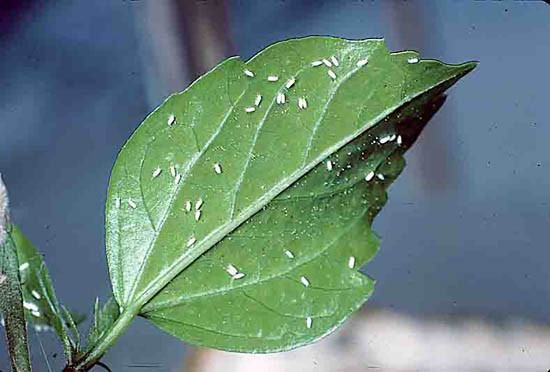Issue 17, September 24, 2012
Whiteflies
Whiteflies are being found commonly in the landscape, feeding on the leaves of flowers and other herbaceous plants as well as hydrangea, other shrubs, and trees. Generally, late season whiteflies can be ignored, as they are too late to cause serious damage to plant health or even cause obvious aesthetic damage. They are 1/16-inch-long insects with white, powdery wings. They sit on leaf undersides and fly off of infested foliage when disturbed, frequently being numerous enough at this time of year to be obvious. They are sucking insects, whose removal of sap can cause leaf distortion.
Three species of whitefly are common in Illinois. The bandedwinged whitefly adult has two dark bands on each front wing. It is hardy in Illinois, feeding primarily on velvetleaf, also known as buttonweed. This weed is common in agricultural and weedy land areas. From late summer into fall, huge numbers of adults migrate to other plants, even flying in large numbers into greenhouses. Bandedwinged whitefly feed as adults on many plant species but does not reproduce heavily on them. Thus, bandedwinged whiteflies usually do not warrant control. An exception is attacks on flowering maple, Abutilon, which is the same genus as velvetleaf.
The other two common species are greenhouse whitefly and silverleaf whitefly. Silverleaf whitefly used to be known as sweet potato whitefly. They do not have dark bands on their front wings, being totally white. Silverleaf whitefly was locally abundant last spring, so apparently it was able to overwinter during the previous uncommonly mild winter. They are common pests in greenhouses. These whiteflies can build up in numbers through multiple generations through the growing season to be common on plants in late summer and fall. They reproduce on many plants and can increase enough to cause damage.

Silverleaf whitefly adults on hibiscus.
Damage appears as wrinkled, curled, cupped, or otherwise distorted leaves. Large amounts of honeydew, excreted from the nymphs and adults, make leaves glossy and sticky. Black sooty mold grows on the honeydew and is another clue that an infestation is present. Sooty mold can reduce the amount of light reaching the leaf surface, resulting in reduced photosynthesis.
Whiteflies, along with a few other insects, are thought to be somewhat transitional between incomplete and complete development. They are considered to have incomplete life cycles, but the last nymphal stage is called a pupa.
Whitefly nymphs and pupae appear as oval, clear to light yellow insects on leaf undersides. Legs are not apparent. The pupae and older nymphs are about 1/16 of an inch long, 1 to 2 millimeters. They are most common on the older, lower leaves of the plant. Their small size and transparent qualities make them difficult to see. Adults and their eggs are most common on the younger, upper leaves of the plant.
Control of whiteflies is usually not necessary unless nymphs are present. Even if nymphs are present, there may not be enough to cause damage or the leaves may be too hardened off to show damage. The whiteflies may cause early leaf fall, but it is probably too late to stimulate new leaf production.
If treatment is warranted, thorough coverage with sprays of insecticidal soap, summer spray oil, or pyrethroids should be effective. Apply weekly, two or three times. Imidacloprid (Merit) applied to the soil as a single application is also effective systemically on whiteflies. (Phil Nixon)
Author:
Phil Nixon